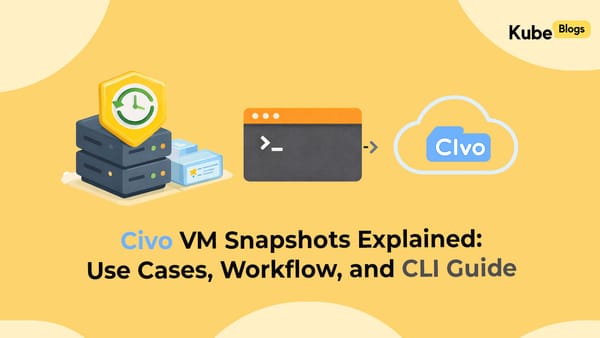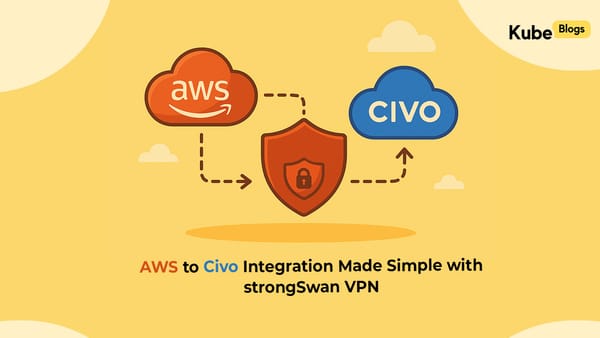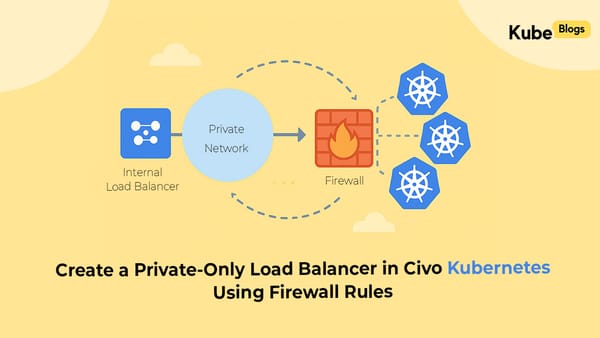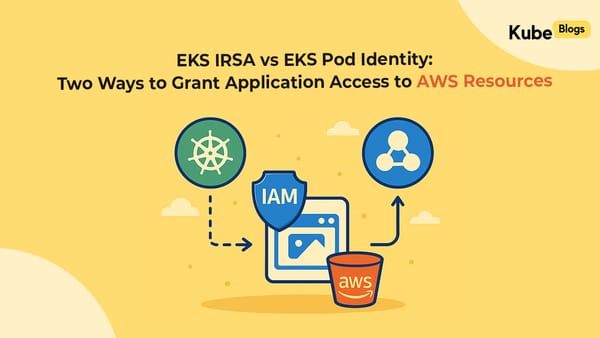Table of Contents
Introduction
When running workloads on Kubernetes, collecting logs from your applications and system components is a basic necessity.
In this guide, we’ll show how to use Fluent Bit to gather logs from different sources in a Kubernetes cluster and send them to Amazon CloudWatch Logs. Fluent Bit is a small, fast log processor designed to run on each node in the cluster as a DaemonSet, collecting logs locally.
This blog covers everything you need to know: how Fluent Bit works, the required Kubernetes setup, and step-by-step configuration. Now let’s look at the architecture to understand how all the pieces fit together.
Fluent Bit Configuration Overview
This setup is built to collect logs from multiple sources inside a Kubernetes cluster, process them based on rules you define, and send the results to Amazon CloudWatch Logs.
Here’s what’s included in the configuration:
- ServiceAccount – Gives Fluent Bit the identity it needs to access the Kubernetes API.
- ClusterRole and ClusterRoleBinding – Grants read permissions on pods, logs, and node metadata.
- ConfigMap – Stores Fluent Bit’s full configuration, split into inputs, filters, outputs, and parsers.
- DaemonSet – Runs one Fluent Bit pod per node to collect logs locally.
- Input Configurations – Define which logs to read (e.g., from container logs, systemd, or host files).
- Filter Configurations – Apply rules to process and enrich logs (e.g., add Kubernetes metadata, match labels, rename fields).
- Output Configurations – Specify where logs are sent (CloudWatch Logs, stdout, or other targets).
Parser Configurations – Handle different log formats using custom or built-in parsing rules.
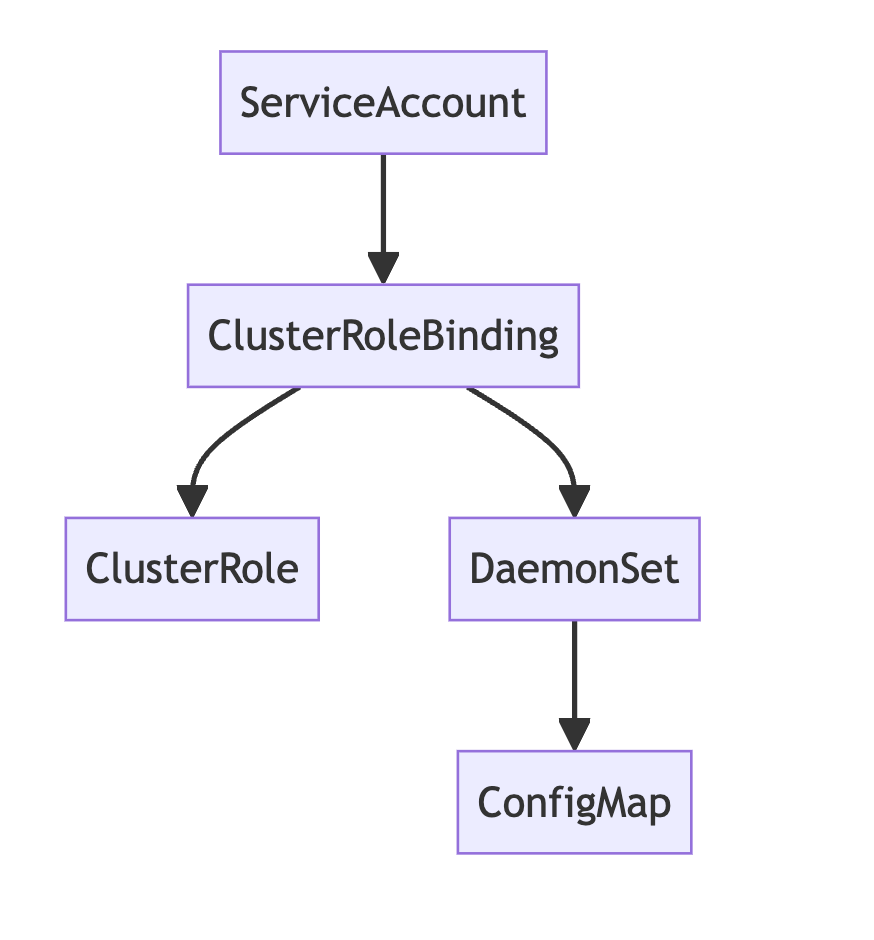
How Fluent Bit Works in This Setup
- Log Collection: Fluent Bit reads logs from application containers, systemd services, and host-level log files.
- Log Processing: Filters apply label-based selection, add metadata, and modify log structure to prepare for export.
- Log Output: Logs are sent to CloudWatch Logs under structured log groups (application, dataplane, host), and optionally to stdout for local debugging.
What is Fluent Bit?
Fluent Bit is a lightweight log processor and forwarder built to collect, process, and send logs from a variety of sources. It’s well-suited for Kubernetes because it runs efficiently as a DaemonSet — one pod per node — and can access all logs on that node.
The way Fluent Bit works is based on a simple pipeline with three main parts:
- Input – This is where you define what logs to read. In Kubernetes, this usually means log files from containers (
/var/log/containers/*.log), systemd services, or host log files. - Filter – After collecting the logs, filters let you process and adjust them. For example, you can enrich logs with Kubernetes metadata, drop logs that don’t match a label, or rename fields to avoid conflicts.
- Output – Finally, the logs are sent to their destination. In this case, we’re sending them to Amazon CloudWatch Logs, but Fluent Bit also supports other options like files, HTTP endpoints, or logging platforms.
In simple terms: Fluent Bit reads logs, processes them according to your rules, and pushes them to the place you specify.
Here’s a basic flow:
[Log File] → [INPUT] → [FILTERS] → [OUTPUT]
In our setup, for example:
- Input might be logs from
/var/log/containers/ - Filter might include adding Kubernetes labels and keeping only logs marked with
logging=enabled - Output sends the logs to CloudWatch under a log group like
/aws/containerinsights/cluster-name/application
Step 1: Set Up AWS Credentials (for non-AWS Kubernetes clusters)
If you're running Kubernetes outside of AWS — such as on-prem or in another cloud environment — Fluent Bit won’t have access to an IAM role like it would in an EKS setup. Instead, you’ll need to provide AWS credentials directly.
1.1 Create an IAM User
In the AWS IAM console, create a new IAM user with programmatic access. Attach the following policy to grant access to CloudWatch Logs:
{
"Version": "2012-10-17",
"Statement": [
{
"Effect": "Allow",
"Action": [
"logs:CreateLogGroup",
"logs:CreateLogStream",
"logs:PutLogEvents",
"logs:DescribeLogGroups",
"logs:DescribeLogStreams"
],
"Resource": "*"
}
]
}
🔹 During creation, select the correct use case:
Application running outside AWS
This tells AWS you're generating a key for workloads running in external environments (e.g., bare metal, another cloud, or local machines).
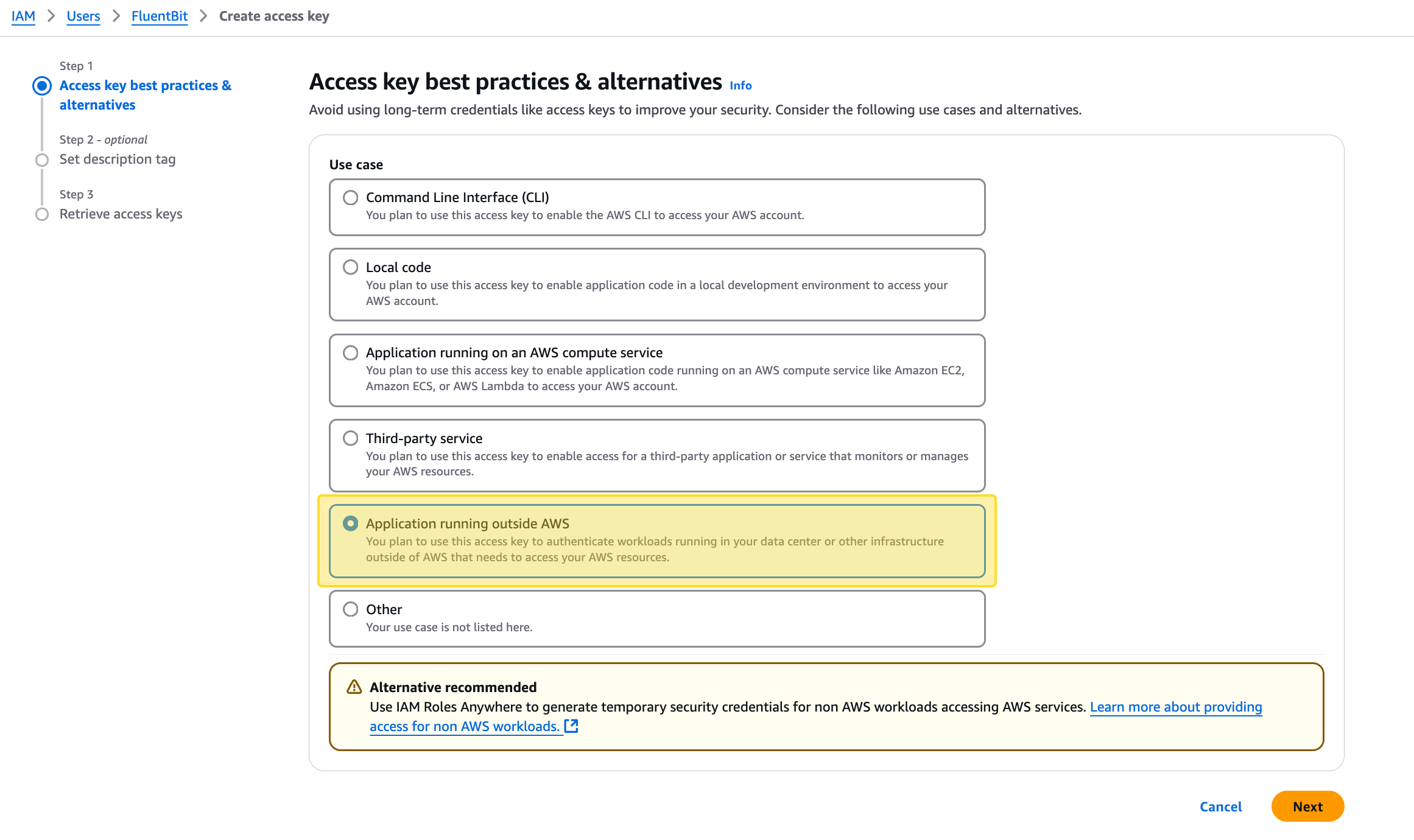
1.2 Retrieve and Store the Access Keys
After completing the user creation, you’ll be shown the Access Key ID and Secret Access Key. You can only view or download the secret once, so save it securely.
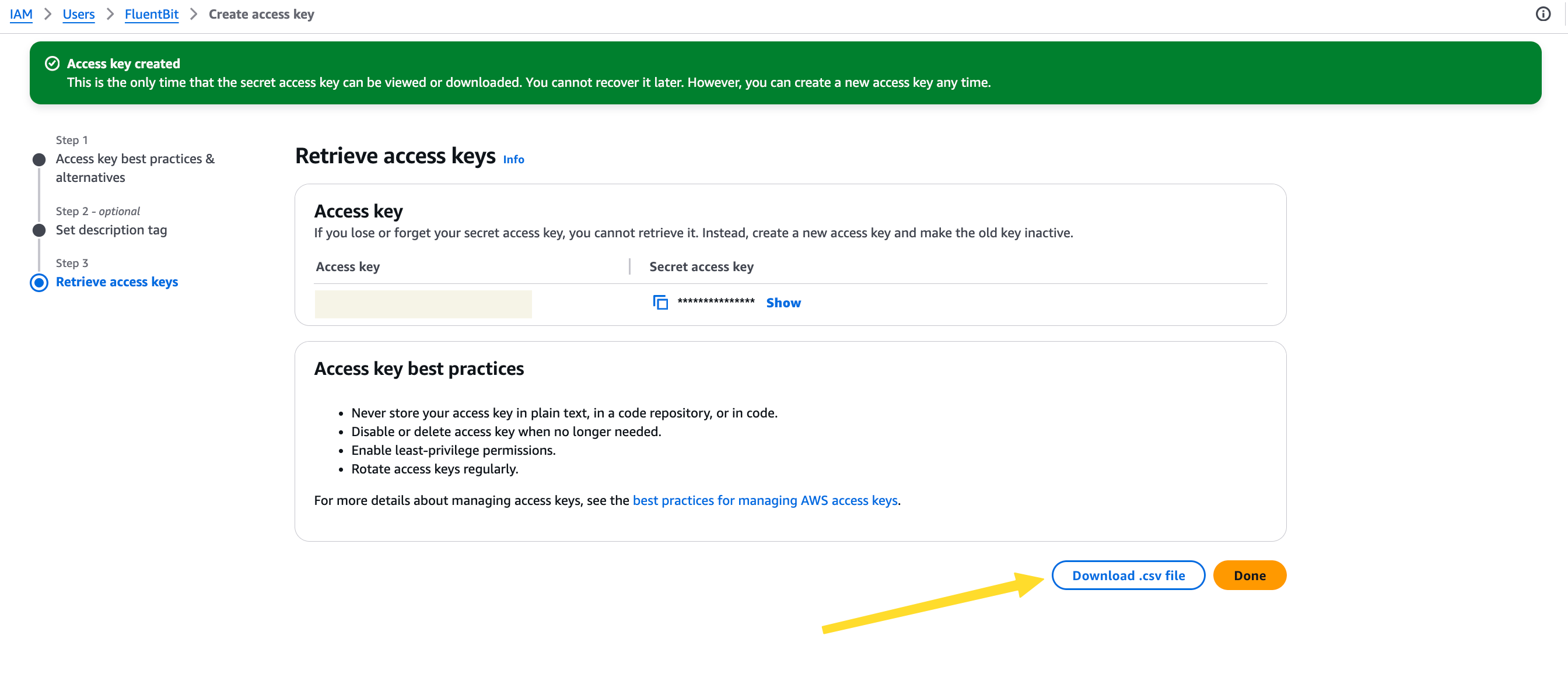
You’ll use these credentials in the next step when creating a Kubernetes secret, so Fluent Bit can authenticate with AWS.
Step 2: Create ServiceAccount and RBAC for Fluent Bit
Fluent Bit needs access to Kubernetes resources like pods, nodes, and logs so it can collect and enrich log data with metadata such as pod names, namespaces, and labels. This is done by assigning the right permissions using a ServiceAccount, ClusterRole, and ClusterRoleBinding.
This step is the same whether you're running inside AWS or on an external Kubernetes cluster.
apiVersion: v1
kind: ServiceAccount
metadata:
name: fluent-bit
namespace: fluent-bit
---
apiVersion: rbac.authorization.k8s.io/v1
kind: ClusterRole
metadata:
name: fluent-bit-role
rules:
- nonResourceURLs:
- /metrics
verbs:
- get
- apiGroups: [""]
resources:
- namespaces
- pods
- pods/logs
- nodes
- nodes/proxy
verbs: ["get", "list", "watch"]
---
apiVersion: rbac.authorization.k8s.io/v1
kind: ClusterRoleBinding
metadata:
name: fluent-bit-role-binding
roleRef:
apiGroup: rbac.authorization.k8s.io
kind: ClusterRole
name: fluent-bit-role
subjects:
- kind: ServiceAccount
name: fluent-bit
namespace: fluent-bitStep 3: Define Fluent Bit Configuration with ConfigMap
Now that Fluent Bit has the necessary permissions, the next step is to configure how it collects, processes, and sends logs. This configuration is stored in a Kubernetes ConfigMap, which is mounted into the Fluent Bit pods when the DaemonSet runs.
The configuration is split into the following parts for clarity and modularity:
fluent-bit.conf– Main entry point that includes service settings and references other config filesapplication-log.conf– Handles logs from containerized applicationsdataplane-log.conf– Handles system-level components likekubelet,containerd, and CNI pluginshost-log.conf– Collects host log files like/var/log/messages,/var/log/secure, etc.parsers.conf– Custom parsers to handle formats like syslog or container-structured logs
apiVersion: v1
kind: ConfigMap
metadata:
name: fluent-bit-config
namespace: fluent-bit
labels:
k8s-app: fluent-bit
data:
fluent-bit.conf: |
[SERVICE]
Flush 5
Grace 30
Log_Level error
Daemon off
Parsers_File parsers.conf
HTTP_Server ${HTTP_SERVER}
HTTP_Listen 0.0.0.0
HTTP_Port ${HTTP_PORT}
storage.path /var/fluent-bit/state/flb-storage/
storage.sync normal
storage.checksum off
storage.backlog.mem_limit 5M
@INCLUDE application-log.conf
@INCLUDE dataplane-log.conf
@INCLUDE host-log.conf
application-log.conf: |
[INPUT]
Name tail
Tag application.*
Exclude_Path /var/log/containers/cloudwatch-agent*, /var/log/containers/fluent-bit*, /var/log/containers/aws-node*, /var/log/containers/kube-proxy*, /var/log/containers/fluentd*
Path /var/log/containers/*.log
multiline.parser docker, cri
DB /var/fluent-bit/state/flb_container.db
Mem_Buf_Limit 50MB
Skip_Long_Lines On
Refresh_Interval 10
Rotate_Wait 30
storage.type filesystem
Read_from_Head ${READ_FROM_HEAD}
[INPUT]
Name tail
Tag application.*
Path /var/log/containers/fluent-bit*
multiline.parser docker, cri
DB /var/fluent-bit/state/flb_log.db
Mem_Buf_Limit 5MB
Skip_Long_Lines On
Refresh_Interval 10
Read_from_Head ${READ_FROM_HEAD}
[INPUT]
Name tail
Tag application.*
Path /var/log/containers/cloudwatch-agent*
multiline.parser docker, cri
DB /var/fluent-bit/state/flb_cwagent.db
Mem_Buf_Limit 5MB
Skip_Long_Lines On
Refresh_Interval 10
Read_from_Head ${READ_FROM_HEAD}
[FILTER]
Name kubernetes
Match application.*
Kube_URL https://kubernetes.default.svc:443
Kube_Tag_Prefix application.var.log.containers.
Merge_Log On
Merge_Log_Key log_processed
K8S-Logging.Parser On
K8S-Logging.Exclude Off
Labels Off
Annotations Off
Use_Kubelet Off
Kubelet_Port 10250
Buffer_Size 0
[OUTPUT]
Name cloudwatch_logs
Match application.*
region ${AWS_REGION}
log_group_name /aws/containerinsights/${CLUSTER_NAME}/application
log_stream_prefix ${HOST_NAME}-
auto_create_group true
extra_user_agent container-insights
dataplane-log.conf: |
[INPUT]
Name systemd
Tag dataplane.systemd.*
Systemd_Filter _SYSTEMD_UNIT=docker.service
Systemd_Filter _SYSTEMD_UNIT=containerd.service
Systemd_Filter _SYSTEMD_UNIT=kubelet.service
DB /var/fluent-bit/state/systemd.db
Path /var/log/journal
Read_From_Tail ${READ_FROM_TAIL}
[INPUT]
Name tail
Tag dataplane.tail.*
Path /var/log/containers/aws-node*, /var/log/containers/kube-proxy*
multiline.parser docker, cri
DB /var/fluent-bit/state/flb_dataplane_tail.db
Mem_Buf_Limit 50MB
Skip_Long_Lines On
Refresh_Interval 10
Rotate_Wait 30
storage.type filesystem
Read_from_Head ${READ_FROM_HEAD}
[FILTER]
Name modify
Match dataplane.systemd.*
Rename _HOSTNAME hostname
Rename _SYSTEMD_UNIT systemd_unit
Rename MESSAGE message
Remove_regex ^((?!hostname|systemd_unit|message).)*$
[FILTER]
Name aws
Match dataplane.*
imds_version v2
[OUTPUT]
Name cloudwatch_logs
Match dataplane.*
region ${AWS_REGION}
log_group_name /aws/containerinsights/${CLUSTER_NAME}/dataplane
log_stream_prefix ${HOST_NAME}-
auto_create_group true
extra_user_agent container-insights
host-log.conf: |
[INPUT]
Name tail
Tag host.dmesg
Path /var/log/dmesg
Key message
DB /var/fluent-bit/state/flb_dmesg.db
Mem_Buf_Limit 5MB
Skip_Long_Lines On
Refresh_Interval 10
Read_from_Head ${READ_FROM_HEAD}
[INPUT]
Name tail
Tag host.messages
Path /var/log/messages
Parser syslog
DB /var/fluent-bit/state/flb_messages.db
Mem_Buf_Limit 5MB
Skip_Long_Lines On
Refresh_Interval 10
Read_from_Head ${READ_FROM_HEAD}
[INPUT]
Name tail
Tag host.secure
Path /var/log/secure
Parser syslog
DB /var/fluent-bit/state/flb_secure.db
Mem_Buf_Limit 5MB
Skip_Long_Lines On
Refresh_Interval 10
Read_from_Head ${READ_FROM_HEAD}
[FILTER]
Name aws
Match host.*
imds_version v2
[OUTPUT]
Name cloudwatch_logs
Match host.*
region ${AWS_REGION}
log_group_name /aws/containerinsights/${CLUSTER_NAME}/host
log_stream_prefix ${HOST_NAME}.
auto_create_group true
extra_user_agent container-insights
parsers.conf: |
[PARSER]
Name syslog
Format regex
Regex ^(?<time>[^ ]* {1,2}[^ ]* [^ ]*) (?<host>[^ ]*) (?<ident>[a-zA-Z0-9_\/\.\-]*)(?:\[(?<pid>[0-9]+)\])?(?:[^\:]*\:)? *(?<message>.*)$
Time_Key time
Time_Format %b %d %H:%M:%S
[PARSER]
Name container_firstline
Format regex
Regex (?<log>(?<="log":")\S(?!\.).*?)(?<!\\)".*(?<stream>(?<="stream":").*?)".*(?<time>\d{4}-\d{1,2}-\d{1,2}T\d{2}:\d{2}:\d{2}\.\w*).*(?=})
Time_Key time
Time_Format %Y-%m-%dT%H:%M:%S.%LZ
[PARSER]
Name cwagent_firstline
Format regex
Regex (?<log>(?<="log":")\d{4}[\/-]\d{1,2}[\/-]\d{1,2}[ T]\d{2}:\d{2}:\d{2}(?!\.).*?)(?<!\\)".*(?<stream>(?<="stream":").*?)".*(?<time>\d{4}-\d{1,2}-\d{1,2}T\d{2}:\d{2}:\d{2}\.\w*).*(?=})
Time_Key time
Time_Format %Y-%m-%dT%H:%M:%S.%LZ
The Fluent Bit configuration is modular and easy to adjust. If you want to filter logs based on a specific namespace, label, or log path, you can make changes directly in the input or filter sections.
🔹 Example: Collect logs only from a specific namespace (e.g., production)
You can do this by adjusting the grep filter section:
[FILTER]
Name grep
Match *
Regex $kubernetes['namespace_name'] production
This change means only logs from pods running in the production namespace will be passed through to the output.
🔹 Example: Collect logs only from a specific label
Already included in the configuration is a label-based filter that checks for this:
[FILTER]
Name grep
Match *
Regex $kubernetes['labels']['logging'] enabledIf you add logging=enabled to any pod’s labels, logs from that pod will be collected. This allows you to opt-in only specific workloads for log shipping.
🔹 Example: Add a custom log path
If your application writes logs to a custom location outside the default container logs, you can add another [INPUT] block to point to that file:
[INPUT]
Name tail
Tag custom.logs
Path /var/log/my-app/*.log
Parser docker
Read_from_Head OnJust be sure that the path is mounted into the Fluent Bit pod via a hostPath volume.
Step 4: Deploy Fluent Bit as a DaemonSet
Before deploying the Fluent Bit DaemonSet, we need to define a separate ConfigMap called fluent-bit-cluster-info. This contains important environment variables such as the cluster name, region, HTTP server settings, and log reading direction.
These values are injected into the Fluent Bit container using env and configMapKeyRef.
apiVersion: v1
kind: ConfigMap
metadata:
name: fluent-bit-cluster-info
namespace: fluent-bit
data:
cluster.name: kubenine
logs.region: us-east-1
http.server: "On"
http.port: "2020"
read.head: "True"
read.tail: "True"
📝 Note: Make sure the namespace matches where you are deploying Fluent Bit (here it's fluent-bit). If you're using the default namespace, update it accordingly.
Now we can move on to Deploy Fluent Bit as a DaemonSet
Step 6: Validate That Logs Are Reaching CloudWatch
Once Fluent Bit is up and running, you’ll want to confirm that logs are being collected and sent to the right CloudWatch log groups.
Go to the CloudWatch Console → Log groups, and look for the following:

Click into one of the log groups — for example, /aws/containerinsights/kubenine/application.
Inside, you should see multiple log streams. These are created per node, per tag, or per Fluent Bit instance, depending on your configuration.
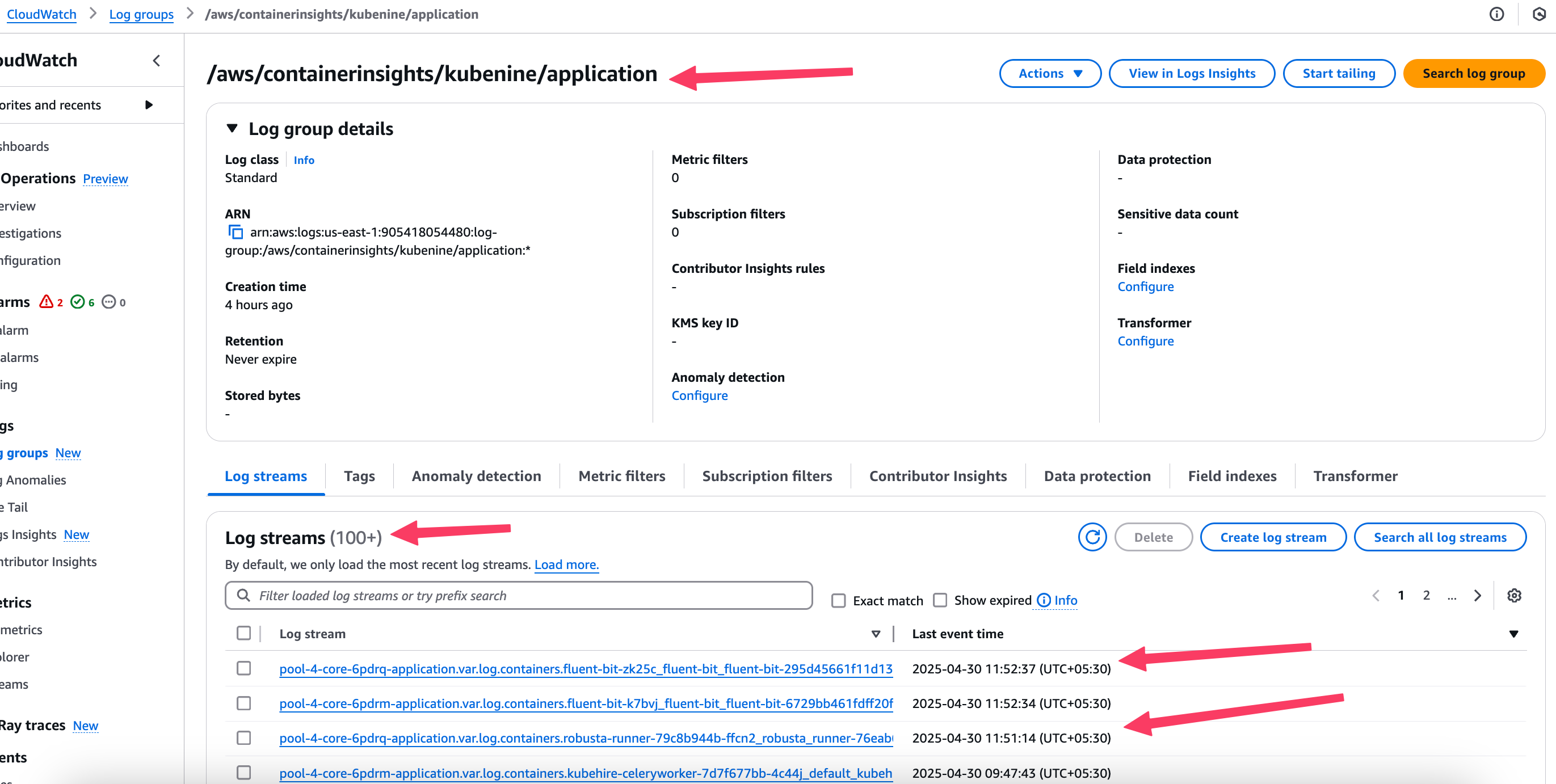
📍 Tip: If no streams are appearing, it usually means logs haven’t been sent yet — check the Fluent Bit pod logs and CloudWatch permissions.
Conclusion
In this guide, we covered how to set up Fluent Bit on a Kubernetes cluster to collect logs and send them to Amazon CloudWatch Logs. You saw how to create AWS credentials (for clusters outside AWS), build a modular configuration using ConfigMaps, deploy Fluent Bit as a DaemonSet, and confirm that logs are reaching CloudWatch.
By the end of this setup, Fluent Bit is collecting:
- Application logs from your containers
- Dataplane logs from services like kubelet and containerd
- Host-level logs from system files such as
/var/log/messagesand/var/log/secure
This setup gives you a working solution to send and manage logs from any Kubernetes cluster, whether it's running inside AWS or elsewhere. You can filter logs by namespace, label, or file path, and forward them to CloudWatch for storage and review.
Need help with setting up an observability strategy for your business that scales? KubeNine can help. Reach out to us on contact@kubenine.com!


